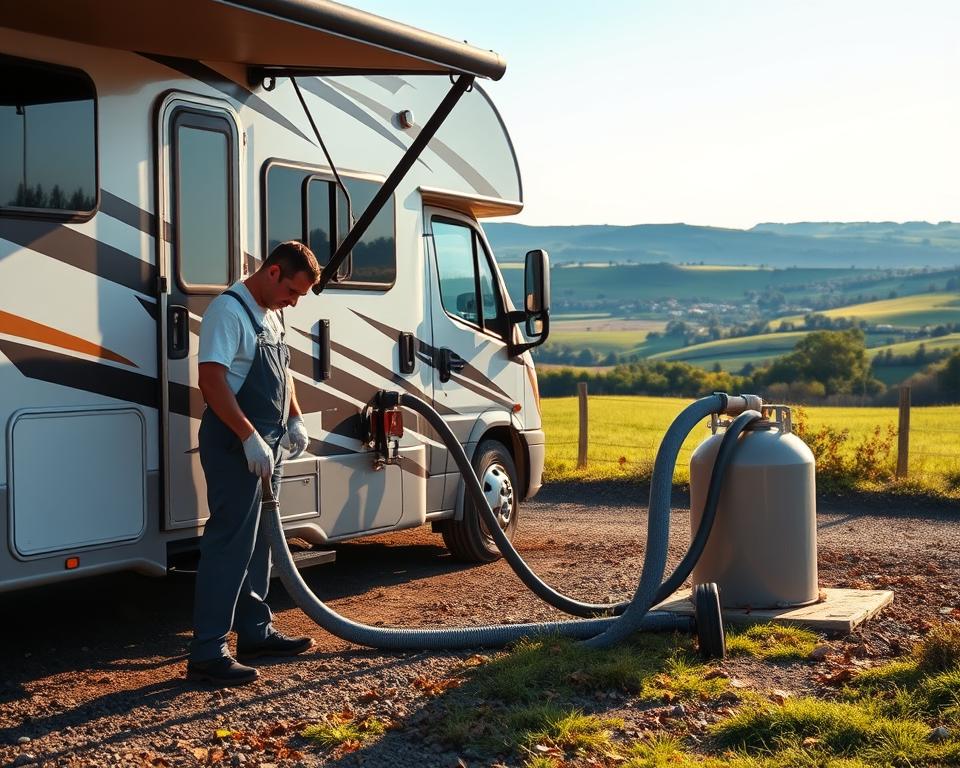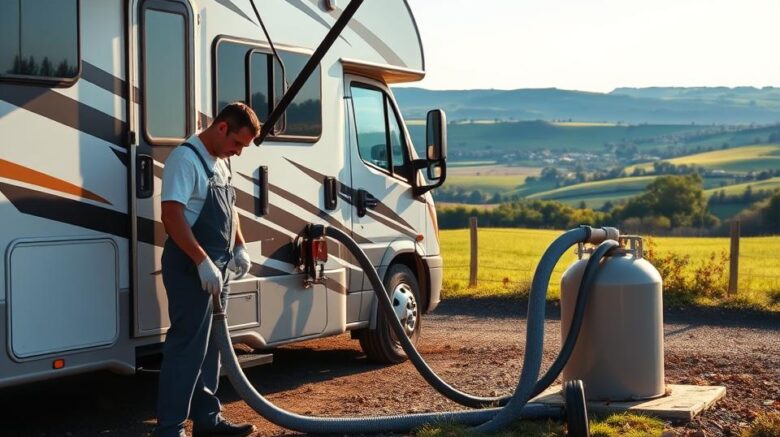RV Sewage Tank Pumping: Key Upkeep Guidelines
Imagine what happens when you ignore your RV’s sewer setup. Numerous campers feel intimidated by tank draining. However, recognizing the need for regular servicing is crucial. Such measures keep your trips worry-free and prevent costly fixes. Learning proper waste disposal is key to your septic health. Here are key pointers on mobile RV septic pumping with upkeep advice to ensure your system operates flawlessly.
Understanding Your RV Septic System
All RVs come with a built-in waste management system. The system comprises a black water tank (toilet), a gray water tank (sinks/showers), and a fresh water tank. Grasping how each part works is key to proper black tank servicing and overall system care.
Drains and vents manage liquid and air movement throughout the system. A good grasp prevents clogs and nasty odors. It’s the foundation of a smooth camping experience.
Maintaining clear, working tanks requires routine effort. Frequently checking tank levels and emptying on time preserves comfort. Proper upkeep extends tank life and enhances every journey.
The Value of Consistent Septic Maintenance
Routine sewage draining preserves functionality and hygiene. Leftover solids lead to smells and clogs, spoiling your trip. Overfilled tanks risk ugly overflows. These incidents mar your travel enjoyment.
Skipping pump-outs leads to pricey repairs. Damage from neglect can shorten component lifespan. Timely emptying keeps your plumbing running smoothly. It prevents unwelcome surprises and roadside emergencies.
Proactive servicing stops clogs. Investing in pump-outs shows you care about your RV. Your trips become more relaxing. By sticking to a dump schedule, you’ll relish the outdoors worry-free.
Finding the Right Dump Frequency
Determining dump intervals needs careful thought. Common guidance suggests a 3–5-day window. Still, it varies with tank size and occupancy. Pinpointing the correct dump time is key for effective wastewater management.
Empty once the black tank reaches roughly 66% full. It ensures good drainage and cuts down on odors. Ignoring it can cause backups and unpleasant odors.
Various factors influence dump frequency, such as
- Number of people on board
- Length of stay
- Type of waste generated
- Tank capacity
Scheduling prevents on-the-road crises. Sync with any public dump station hours. Tracking your usage helps forecast dump needs.
| Usage Scenario | Pumping Frequency |
|---|---|
| Weekend Getaway (2 people) | Every 3–4 days |
| Long Stay, Four to Six Occupants | Every 2–3 days |
| Seasonal Living (2–4 people) | Weekly or Bi-Weekly |
Monitor fill levels and usage patterns. Staying attentive guarantees a pleasant trip.

Best Practices for Dumping Your Tanks
Correct dumping preserves system health and prevents issues. Always empty the black tank first to protect the gray tank. This prevents dirty water from fouling the clean.
Using a high-quality hose minimizes leaks and ensures smooth dumping. Tighten connections to stop spills. After emptying, flush the black tank with plenty of water. It clears lingering waste for a cleaner tank.
Scout dump spots along your route. This preparation streamlines your dump routine.
To summarize, use these steps:
- Empty the black water tank first.
- Use a top-quality sewer hose.
- Flush the black tank thoroughly after emptying.
- Plan your dump station locations.
Following these guidelines simplifies black tank maintenance.
Tank Handling and Upkeep Best Practices
Grasping correct handling of black and gray tanks ensures system health. Maintain a bit of water in the black tank to aid waste decomposition.
Refrain from disposing non-biodegradable items. Use only RV-compatible paper. Regular checks spot leaks or cracks before they worsen.
Occasional treatments boost system performance. They introduce microbes that digest solids effectively. Simple steps ensure smooth tank operation.
- Check for leaks and damage often.
- Apply RV-specific chemical treatments.
- Keep vents clear to avoid odors.
Adhering to these practices safeguards your system. You’ll enjoy more worry-free trips.
RV Septic Tank Pumping: Key Tips for Success
To pump your tank effectively, follow a methodical approach. Proper disposal prevents issues—only dump at approved stations. Know your tank’s capacity to avoid overflows.
Check tank indicators regularly to time pump-outs. Routine scheduling preserves your septic system and travel enjoyment. Setting a dumping schedule improves system efficiency.
Flush well after every emptying. It ensures each dump is cleaner than the last. Such tactics keep your rig in top shape and improve your travel experiences.
Common Mistakes to Avoid When Maintaining Your RV Septic System
Upkeep prevents trip interruptions. Not using enough water in the black tank leads to buildup. Proper flushing dissolves waste better.
Flushing inappropriate items blocks pipes. Avoid non-dissolvable products like feminine hygiene items. They cause backups and costly service calls.
Leaving the black valve open too early is a mistake. Open valves let water out but hold solids, causing residue. Only open when ready to empty for a complete clean.
Knowing these pitfalls helps maintain efficiency. Steering clear of these mistakes ensures durable performance.
When to Seek Professional Septic Services
Knowing when to hire pros preserves system health. Persistent odors often indicate complex issues. Slow drains point to potential clogs or buildup.
Visible residue at dump points requires attention. Such situations usually need high-pressure cleaning. Experts use specialized tools to clear stubborn clogs.
Routine professional inspections catch hidden issues early. Acting on findings quickly prevents bigger problems. Professional service ensures proper functionality.
Ongoing Septic Care Tips
Smart upkeep ensures lasting system performance. Scheduled dumps preserve longevity and operation. Routine rinses clear residue and stave off expensive breakdowns.
Implementing clean cycles safeguards tank health. Checking seals and joints avoids leaks. Choosing eco-friendly treatments avoids damage.
Keep these habits in mind:
- Stick to a pump-out timetable.
- Rinse often to remove solids.
- Sanitize twice a year.
- Inspect parts frequently for wear and tear.
Investing in prevention brings peace of mind. Routine service lets you focus on the scenery, not your sewer.
Final Thoughts
Good septic care ensures enjoyable trips. Knowing system function and cleaning steps stops issues. Regular black tank maintenance improves efficiency. It enhances every mile.
Consistent inspections and care deliver trouble-free trips. Dependable sewage service backs every adventure. These routines prime your rig for future rides. So you can focus on making memories, not dealing with tanks.
